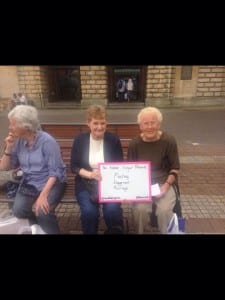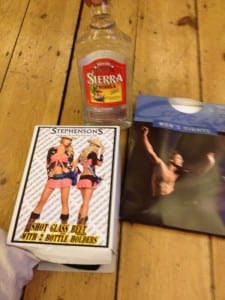No Added Sugar (2014)
The original idea for the wedding scene was to create a section in the performance that showed how couples who are planning to get married can be forced into big extravagant weddings by friends and family. Some couples set out to get married in a small venue with just their nearest and dearest there, but quite often it seems the people closest to them get involved and persuade them otherwise. The initial aim of the scene was to remind the audience, that even though fancy weddings can be beautiful, underneath all that what really matters is that two people love each other enough to promise themselves to one another for the rest of their lives. Firstly we talked about how planning all the different things that need to be organised in a wedding can be like a military mission. This led to many different ideas for a scene. We wanted to create a live wedding plan on stage for the audience to see, we hoped we could write it in a way where the audience could see a couple be cajoled into this wedding by us. The idea that followed was that we wanted a main ‘military type’ who would be in charge of giving out different jobs to each actor on stage, one of our first ideas was to place the live feed onto a map which would show the seating plan and be ready for the audience to see. With this idea in mind, I began to write the scene… we made a list of the most important factors of a wedding this included…
The Date.
The Venue.
The catering.
The dress.
The Music.
The Idea finally progressed into a scene that required audience participation. We thought there was no better way to show the audience how a wedding can manipulated then using two audience members who had never met before and planning their wedding! When writing the scene, I at first wrote it in a military style, having each actor with a different role within the wedding an example of this is….
“This is Sam… Wires, communications. She can write invitations like you’ve never seen. Calligraphy that’ll make you weep openly. She’ll be in charge of fonts and napkin folding.”
Throughout the process of devising our show, one of our main influences has been ‘Filter Theatre’. From the start we always aimed for our piece to have a relaxed atmosphere which gave the feel of organised chaos. Filters work also has this feel… “Although diminishing the audience, the timing of the event was actually crucial to the success of Filter’s performance; the informal atmosphere aimed for was enthusiastically embraced by an audience who had mostly just arrived from the pub. The production represented, in many ways, the RSC’s ‘‘night off’’, with a party feel amongst many sections of the auditorium” (Kirwan, 2009). Although lots of our performance showed similarities with Filter Theatre, I feel the main scene which we took real inspiration from them would have to be the wedding scene. In their rendition of ‘Twelfth Night’ Filter Theatre used lots of different audience participation the first time they use it in the show is when “Viola engaged with the audience directly at the start, making them complicit in her plan by borrowing a hoodie and baseball cap from a boy in the stalls, before completing her disguise by sticking a pair of socks into her pants” (Kirwan, 2009). This act proved extremely amusing, an effect we hope can be achieved in our scene. The scene that we took the most inspiration from was the party scene, which used audience participation to create an ‘spontaneous party’ this was all set around the song “What is love?” it began with an onstage whisper of the song, and built up until it was being repeated and sang louder and louder the onstage actors then began to involve the audience as ‘Sir Andrew’ who “wore a Velcro cap with sticky balls attached to it”(Kirwan, 2009). He asked the audience to throw the balls onto the stage, sometimes missing it but congratulating them when they had succeeded. The party then began to build up when the band joined in and the stage manager emerged with pizza boxes which were given out to audience members. When watching this scene I remember feeling as if I was apart of the action from start to end. This style is what we wish to create with the wedding scene, and I feel having two audience members on stage will help to achieve this.
Works Cited
Kirwan, P (2009), ‘Review of Shakespeare’s Twelfth Night (directed by Sean Holmes for Filter Theatre) at the Courtyard Theatre, Stratford-upon-Avon, November 2008′, Shakespeare (1745-0918), 5, 1, pp. 114-117.
Kirwan, p (2013) Twelth Night at the curve theatre. [online] Exeunt. Available from: http://exeuntmagazine.com/reviews/twelfth-night-4/ [Accessed 30 April 2014]
No Added Sugar (2014)



